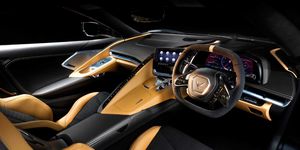- GM used 3D printing extensively to develop the C8 Corvette ahead of its unveiling.
- The ability to quickly iterate and build parts helped the automaker quickly pivot to shield making for medical workers during the coronavirus pandemic.
- Parts that have been 3D printed can also be used to train the robots on the production line ahead of the final part being delivered.
If you’re wondering when you’ll see 3D-printed production parts, some will end up in vehicles “very soon,” according to GM. But the tech will only be used when appropriate and in a way that doesn’t sacrifice safety, GM spokespeople told Car and Driver.
Before COVID-19, GM was already using 3D printing to help it develop new vehicles including the Corvette. Then the pandemic grew, and the automaker was able to quickly use those same machines to build face shields for medical staff. After the first batch went out, they got feedback from hospitals were able to quickly iterate on their design. It’s a situation that clearly was not expected by the additive design and manufacturing team. But it illustrated just how quickly a design can be adjusted and output thanks to 3D printers.
“We were able to quickly do and quickly turn on with 3D printing in terms of supporting COVID relief efforts and supporting those workers on the front line, as well as, frankly, the folks at our own company as we got back to work to ensure that they’re safe and comfortable when they’re working with face shields,” Kevin Quinn, GM director of additive design and manufacturing, told Car and Driver. Quinn said that 3D printing has helped GM build parts and products faster and in ways that it previously couldn’t.
That speed and ability extends to the mid-engine C8 Corvette. Ahead of its unveiling to the world, the automaker was able to build a nonoperational version of the vehicle that was 75 percent 3D printed. It allowed the team to determine how everything fit together but also made sure that items and areas were accessible during the manufacturing process. If something was off, they could quickly change it. It’s how GM was able to prototype the right-hand-drive Corvette for the U.K. and other regions that drive on the wrong side of the road.
There was one item that had mechanical 3D parts during development: the retractable hardtop used extensive 3D printed parts to gauge the functionality of opening and closing very early in the process. If there were issues, they could quickly address them.
“We can quickly get a prototype part. We can iterate that part maybe five times in a week so you make sure you get the right design,” Quinn said.
This can be especially important when it comes to making sure that sensors for vehicles with driver assistance features are aimed in the right direction. “That is kind of a Rubik’s Cube to get together. You can’t change the camera. What you change is the supporting bracket to maybe put it into a different angle view,” Quinn said. “We do that quite a bit on our development vehicles. Almost on a daily basis.”
The team is not only using parts to make sure they fit well in an upcoming vehicle but also to help get the production line ready to build that vehicle. The 3D printed items can be used to train the robots that’ll be building the vehicle on a part by part basis. “You can print a couple of parts and that’s good enough for robots to be able to assess access points and buildability,” Ron Daul, GM director of additive manufacturing, told Car and Driver.
Some of the GM team do envision a time in the future where an app or service is available letting owners download and print parts at home via a subscription service. Of course, that would require higher-quality machines that can handle materials far stronger than what the average at-home 3D printer can handle. So don’t expect it to happen anytime soon.
For now, GM continues to invest in 3D printing with two new facilities, both in Warren, Michigan. Both will help the company continue to use 3D printing to develop and build new cars and if needed pivot again to help build supplies for the medical world.
This content is imported from {embed-name}. You may be able to find the same content in another format, or you may be able to find more information, at their web site.
This content is created and maintained by a third party, and imported onto this page to help users provide their email addresses. You may be able to find more information about this and similar content at piano.io







